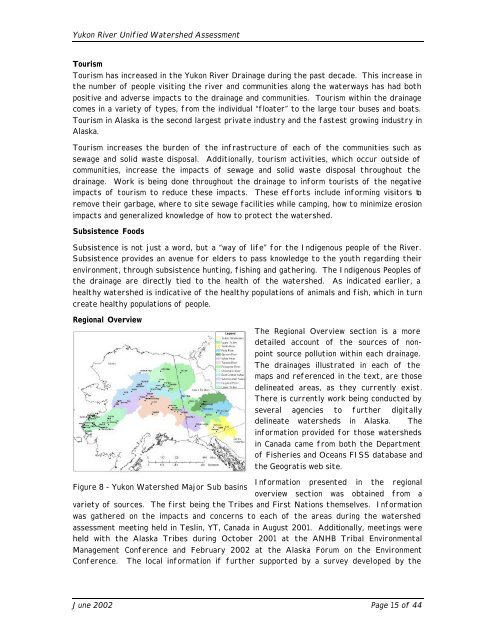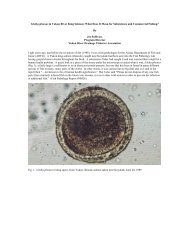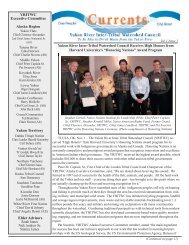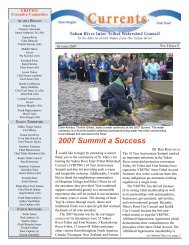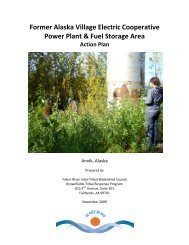Yukon River Unified Watershed Assessment - Yukon River Inter ...
Yukon River Unified Watershed Assessment - Yukon River Inter ...
Yukon River Unified Watershed Assessment - Yukon River Inter ...
Create successful ePaper yourself
Turn your PDF publications into a flip-book with our unique Google optimized e-Paper software.
<strong>Yukon</strong> <strong>River</strong> <strong>Unified</strong> <strong>Watershed</strong> <strong>Assessment</strong><br />
Tourism<br />
Tourism has increased in the <strong>Yukon</strong> <strong>River</strong> Drainage during the past decade. This increase in<br />
the number of people visiting the river and communities along the waterways has had both<br />
positive and adverse impacts to the drainage and communities. Tourism within the drainage<br />
comes in a variety of types, from the individual “floater” to the large tour buses and boats.<br />
Tourism in Alaska is the second largest private industry and the fastest growing industry in<br />
Alaska.<br />
Tourism increases the burden of the infrastructure of each of the communities such as<br />
sewage and solid waste disposal. Additionally, tourism activities, which occur outside of<br />
communities, increase the impacts of sewage and solid waste disposal throughout the<br />
drainage. Work is being done throughout the drainage to inform tourists of the negative<br />
impacts of tourism to reduce these impacts. These efforts include informing visitors to<br />
remove their garbage, where to site sewage facilities while camping, how to minimize erosion<br />
impacts and generalized knowledge of how to protect the watershed.<br />
Subsistence Foods<br />
Subsistence is not just a word, but a “way of life” for the Indigenous people of the <strong>River</strong>.<br />
Subsistence provides an avenue for elders to pass knowledge to the youth regarding their<br />
environment, through subsistence hunting, fishing and gathering. The Indigenous Peoples of<br />
the drainage are directly tied to the health of the watershed. As indicated earlier, a<br />
healthy watershed is indicative of the healthy populations of animals and fish, which in turn<br />
create healthy populations of people.<br />
Regional Overview<br />
The Regional Overview section is a more<br />
detailed account of the sources of non-<br />
point source pollution within each drainage.<br />
The drainages illustrated in each of the<br />
maps and referenced in the text, are those<br />
delineated areas, as they currently exist.<br />
There is currently work being conducted by<br />
several agencies to further digitally<br />
delineate watersheds in Alaska. The<br />
information provided for those watersheds<br />
in Canada came from both the Department<br />
of Fisheries and Oceans FISS database and<br />
the Geogratis web site.<br />
Information presented in the regional<br />
Figure 8 - <strong>Yukon</strong> <strong>Watershed</strong> Major Sub basins<br />
overview section was obtained from a<br />
variety of sources. The first being the Tribes and First Nations themselves. Information<br />
was gathered on the impacts and concerns to each of the areas during the watershed<br />
assessment meeting held in Teslin, YT, Canada in August 2001. Additionally, meetings were<br />
held with the Alaska Tribes during October 2001 at the ANHB Tribal Environmental<br />
Management Conference and February 2002 at the Alaska Forum on the Environment<br />
Conference. The local information if further supported by a survey developed by the<br />
June 2002 Page 15 of 44


